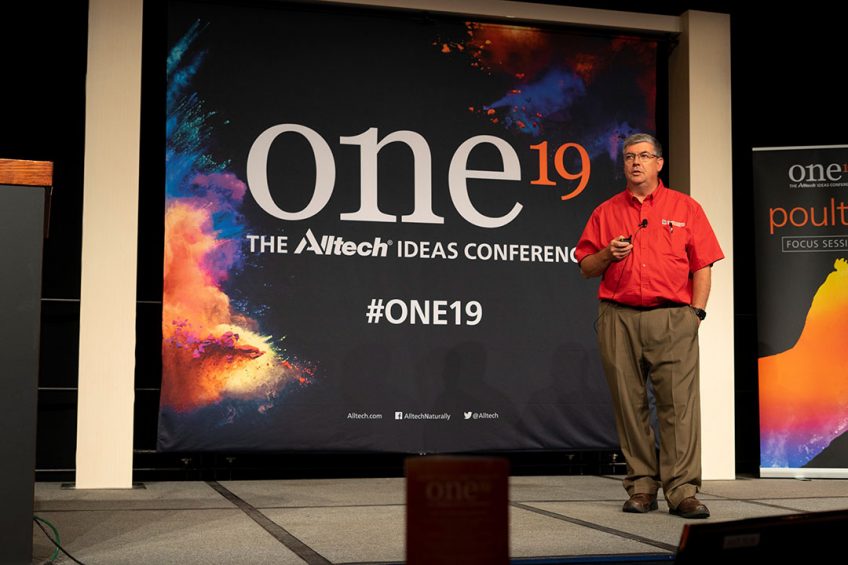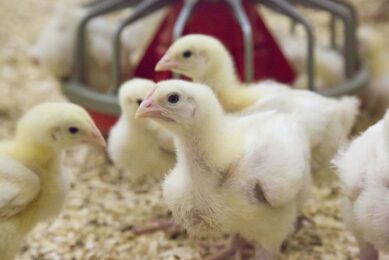Managing moisture to maximise broiler performance

Keeping moisture levels in the poultry house under control is a sure-fire way to minimise a wide range of potential health problems and improve performance. The University of Georgia’s Dr Brian Fairchild gave the Alltech ONE conference tips on getting it right.
Any broiler producer will know that ensuring temperature targets are hit is one of the fundamental elements of good house management. But farmers should be thinking more about how moisture levels are controlled – a measure “just as important”, according to the University of Georgia’s Brian Fairchild. “We have a very specific target temperature that we want to maintain in houses,” he told the Alltech ONE conference, “And we’ve worked for years to do a good job of maintaining that. We need to do the same thing with relative humidity.”
Targets- humidity levels in poultry houses
He said poultry house environments need to be between 40-60% relative humidity – but still finds farmers who focus on temperature without ever checking humidity levels. “To control water levels, we’ve got to ventilate the house properly.” Determining how to do that means getting minimum ventilation right. “In typical wintertime conditions, to remove one gallon of water we need to exchange about 20,000 cubic feet of air,” he said. A 48 inch fan running for a minute will remove 1 gallon of water under typical winter conditions in the Southeast US, added Dr Fairchild.
When it comes to calculating the amount of ventilation required as a minimum it must first be considered that birds retain about 20% of the water they drink. The rest goes into the environment through respiration, excretion and manure, explained Dr Fairchild. So, for every 1,000 gallons of water introduced to poultry houses, 800 gallons needs to be removed to maintain the moisture balance in the environment. That means 5,500 cu ft of air needs to be moved every minute to maintain the moisture balance. The University of Georgia has developed an iPhone app to help producers make these minimum ventilation calculations easily, and for those without smartphones, a spreadsheet that does the same job can be found at www.poultryventilation.com.
Measuring poultry house environments
But Dr Fairchild warned against relying on the app or other charts, and says measuring poultry house environments is incredibly important. “Charts are a starting point – they are not a complete guide. For example, they assume that fans are running at 100% efficiency. “We need to be actually measuring what’s actually going on in the house, in the form of relative humidity, and tweaking our ventilation based on that.”
When starting out with a renewed focus on ventilation control, the first thing to look at is historical water data. With that, the app or spreadsheet can generate a “basic curve” that will indicate where minimum ventilation levels should be. “From then, we need to make adjustments. We need to be monitoring relative humidity every day – especially at night. If you can’t do it at night then do it early in the morning, before it starts to warm up. That will give you a very good idea of what the maximum relative humidity is overnight.”

Once measurements are being taken, farmers can begin to tweak levels to ensure they are below 60%, ideally. “One of the best things about monitoring relative humidity is that all very important variables follow this,” said Dr Fairchild. Ammonia, for example, is higher when relative humidity is higher – “the drier the house, the less ammonia we are able to detect,” he explained. CO2, as well, is known to decrease when relative humidity is lower. “If your relative humidity is over 60%, then chances are that you have poor litter and air quality in that house.” Getting relative humidity closer to – or even below – 40% will mean dry, friable litter. But, depending on the local environment, this can add cost to the growing cycle. “Drier litter requires more ventilation. More ventilation means, more heat. Which means that our heating costs are going to go up to get a drier house. So, we need to be as efficient as possible when we heat our houses.”
Also read: Strategies to master heat stress in poultry
Efficiency
Minimising the additional costs associated with higher ventilation means ensuring insulation is spot on. Checking that drinkers are operating optimally, and not leaking water onto litter is one such area where efficiencies can be lost, as is ensuring poultry houses are as insulated as possible. And bird distribution is an important element of management. “Make sure the birds are evenly distributed. Otherwise, you’ll get more birds on one part of the house, and the litter will deteriorate more quickly than where there are fewer birds.” Attic vents, which introduce air into poultry houses where the environment is at its warmest, are worth considering he added, “Typically we see about 20% more ventilation when we use attic inlets, without a 20% increase in heating costs.”
“We want to make sure that air enters the inlet, and not come in through cracks or loose areas in the house,” said Dr Fairchild. “By ensuring that air comes in through the inlets, like it’s supposed to, we can precondition that air and warm it up, using that warmer air at the ceiling. As we warm that air, we increase its moisture-holding capacity, which lowers our relative humidity.” Farmers should be doing static pressure tests regularly, to monitor leakage, saving on any potential extra costs that using ventilation to keep relative humidity down can create, by plugging gaps letting air in unnecessarily.
Alltech ONE conference
This year, some 3,500 delegates descended on Lexington, Kentucky, for Alltech’s annual jamboree. The 3-day event hosted more than 120 speakers who gave a wide range of presentations – from poultry ventilation to TV’s Bear Grylls talking about surviving his time in the armed forces. Alltech also launched its Planet of Plenty website, which seeks to recognise those “putting the power of agriculture to work” to improve food production. “To create a more abundant world, we must collaborate across industries and geographies, and discover, test and apply new ideas,” said Mark Lyons, Alltech president. “Our personal journeys will be unique and diverse, but if we work together, our destination can be the same: a Planet of Plenty in which there is enough nutritious food for all, the world’s resources are responsibly managed for future generations and the environment is safe for people, animals and plants to thrive in harmony.”












